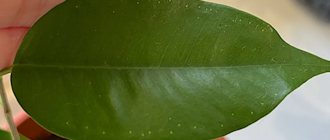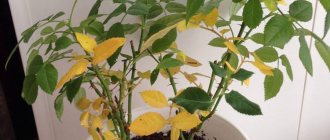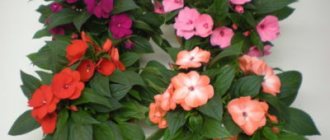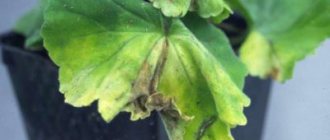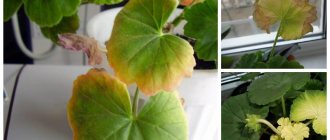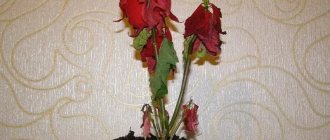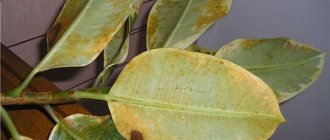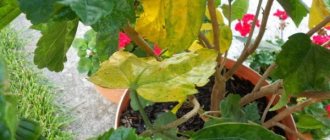Causes of yellowing and falling leaves of balsam
What to do if the leaves of Vanka’s wet balsam turn yellow and fall off?
Let's figure out what are the most common mistakes people make when caring for this flower. So, why can the leaves of a wet Rolyflower turn yellow:
- Direct sunlight.
- Not enough light.
- Little watering.
- Low room temperature.
- Various pests.
- Dried leaves were not cut off in time.
- The leaves were not sprayed.
- In a cold room, you cannot constantly keep the soil wet.
- The plant is not adapted to proximity to other flowers.
- There is dry air above a hot radiator.
- Tobacco smoke.
As follows from the above, when maintaining any plant, balsam is no exception; it is necessary to create certain conditions in which this particular specimen will be comfortable.
What conditions does a flower need to create:
- It is necessary to provide the wet robe with sunlight, but not place it in direct sunlight.
- The flower loves moisture, but in winter it needs to be sprayed more and watered less.
- The temperature should not be too low, below 17ºC, (in winter it can be temporarily 13ºC) and should not exceed 30ºC. The most comfortable temperature for this plant is 21-25 ºC.
- The plant prefers moist air.
- Fertilize with mineral compounds (potassium-phosphorus and nitrogen fertilizers).
- Replant a flower - on average once every 5 years, even more often if possible.
- The flower must, if necessary, be carefully trimmed to form a bush. We are talking about old yellowed leaves and faded peduncles, if you do not need seeds.
- The flower should not be placed on a windowsill in direct sunlight; diffused light or partial shade will do.
- The soil needs to be loose and nutritious.
The best soil mixture for a flower is turf soil, which contains sand and humus. In summer, the plant must be watered daily and a lot, and in winter, moderate watering is indicated. In the summer, sometimes the flower is planted in open ground.
Violation of care standards: consequences and combating them
Failure to comply with the conditions for caring for the plant leads to the fact that the leaves of the balsam wither, and the growth of Vanka wet slows down significantly. These representatives of the flora originated in nature in regions where the climate is humid and warm, and sudden temperature changes and frosts are not observed. Hence all the requirements of the plant.
If Vanka has variegated foliage, then the plant can suffer even at 15 - 17 degrees Celsius above zero, and during flowering - no lower than plus 18 - 20 degrees Celsius. If the room is too hot, the buds will fall off. The only “antidote” to this process is an artificial decrease in temperature.
In conditions of lack of sunlight, you can experience:
- excessive stretching of shoots;
- low level of bud formation and opening;
- slower foliage growth.
In direct sunlight, balsam will quickly lose moisture, its natural metabolic processes are disrupted, and thus the plant may weaken before our eyes.
It is not for nothing that balsam is nicknamed Vanka wet; its soil should be moist, but the air should also be humidified.
Leaves fall only on those specimens that are cared for in clear violations of the rules. Everything is important: from the light that comes through the window, to heating devices, from the amount of evaporation from leaves, to the level of humidity in the room.
Short-term drops in temperature also have a bad effect on this representative of the flora. If the gardener prefers natural conditions in the summer for Vanka wet, then it is better to stop placing the pots on the balcony or in the garden in the second half of summer and early September. Cold nights will definitely affect the health of the plant.
Its leaves contain a number of useful microelements, so they are often used to prepare salads and decoctions. It is also successfully used as part of homeopathic remedies that are aimed at combating gout and urolithiasis. Toxoid preparations are often also created on the basis of balsam. From the roots of Vanka wet they make a hair dye that almost all representatives of the fair half of humanity are familiar with, if not in practice, then in words - henna. Therefore, it is important to provide all the conditions so that the balsam pleases the eye and in no case weakens.
A lack of nutrients, as well as other violations of care rules, will certainly affect the condition of the plant. During active growth, drying out of the soil is often observed - you just need to increase the frequency of watering and everything will return to normal. But if this is not done, the growth of new shoots will at least slow down, flowering will stop, and the leaves will turn yellow and fall off. But that's not all. Weakening of the plant, its exhaustion and disturbances in the level of humidity in the room are excellent conditions for the appearance and rapid growth of mites and other insects on wet Vanka.
Pests, diseases and adverse conditions
Watering balsam must be approached with all responsibility, so that there is enough moisture, but not excessive, especially in winter. You need to water moderately, but regularly spray the leaves to prevent the spread of the fungus. With excess moisture, the soil begins to rot, creating the necessary conditions for the appearance of fungus. In this case, you need to transplant it into another pot as soon as possible, with new soil and plenty of drainage. If the plant is severely damaged, it is better to take cuttings and grow a new healthy plant.
The scale insect is extremely dangerous for balsam. If you find “tubercles” of scale insects, you need to remove them mechanically. And then treat the plant with an alcohol or soap solution, perhaps using a soap-kerosene emulsion. If the lesions are significant, then the following chemicals can be used: Aktara, Actellik or Bankol.
Spider mites are also dangerous. Very often the cause of the appearance is excessively dry air or proximity to diseased plants. The mite may be seen on the leaves in the form of thin cobwebs. The parasite can be destroyed using the previously mentioned drugs plus Neoron or Agravertin.
If the leaves turn yellow and fall off, this is a sign of the appearance of whitefly - a tiny white fly. It should be noted that it is not the adults who harm the flower, but their larvae, similar to aphids. Turning over the leaves of an infected balsam, on the back of the leaf you can see many small insects secreting sweet juice, as a result, the leaves appear sticky. In pest control, the same drugs work effectively as in the case of scale insects and mites, plus Fitoverm. Among the folk remedies, a soap solution made from laundry soap, a solution from dishwashing detergent, and onion tincture have proven themselves to be effective.
Indoor balsam. Description and care rules
The genus Impatiens Balsamina includes more than 500 species of herbaceous perennial and annual plants. In nature, it grows over a fairly vast area of the globe: central Europe, Africa, Asia and North America. The culture came to Europe in 1596 and immediately gained enormous popularity among gardeners.
At home, balsam is grown as a perennial. The plant is one of the most common and beautiful indoor flowers.
Among the people, balsam has several names. Thanks to its colorful flowers, it is called the sparkle. Touch-me-not or tear-grass reflects the peculiarity of the crop - at the slightest touch to the dry seed pod, it immediately explodes, shooting out the seeds. Wet weed is another nickname received due to the same strong moisture-loving nature of the plant, as, for example, soleirolia, alocasia or stromantha.
The culture is characterized by branching fleshy stems. The foliage color ranges from light green to dark and even burgundy, depending on the type and varietal form.
Types and varieties of indoor balsam
Among the perennial indoor species, the most common are Waller's balsam (Impatiens walleriana) and Walker's balsam (Impatiens hawkeri), native to New Guinea, from which amazing long-flowering hybrids have been obtained, collectively called "New Guinea balsam." Flower growers value them for their numerous spectacular flowers in a wide range of shades.
Some popular varieties of Impatiens hawkeri:
— “Orange Blaze” with bright orange flowers;
- 'Celebration Blush Pink' with large soft pink flowers against dark green foliage;
— “Celebration Lavender Glow” lavender-pink bloom;
— white-orange “Sweet Orange”;
Sweet Orange
— “Celebration Raspberry Rose” with large crimson flowers;
— dark red “Celebrette Deep Red”;
— unusual purple “Celebrette Purple Stripe” about 30 cm in height;
- 'Infinity Lavender' displays large lavender-purple flowers all summer and fall;
Infinity Lavender
- 'Painted Paradise Lilac' produces large lilac flowers against a backdrop of variegated foliage;
- “Painted Paradise White” - snow-white blooms against a background of yellow-green foliage;
- 'Paradise Cherry Rose' displays vibrant red-pink flowers;
— “Paradise Mango Orange” with bright orange flowers.
Waller's balsam gave gardeners magnificent double hybrids and varieties similar to roses, for example, soft orange “Musica Pastel Salmon”, “Musica Bicolor Dark Red” with white and red petals, pink “Fiesta Lavender Orchid”, snow-white “Musica Pure White” , lilac “Musica Pink Aroma”, cream “Musica Pastel Salmon”, burgundy “Cherry Red”.
There are charming dwarf hybrids with large double flowers.
Thanks to constant selective breeding, New Guinea and Wallera balsams have become favorites in home floriculture.
Caring for indoor balsam
Lighting
The crop tolerates low light conditions when planted in open ground. However, as a houseplant, balsam requires bright, diffused light, otherwise flowering will not begin or will be poor, the shoots will stretch out and weaken, and the leaves will become small. The best exposure is eastern or western windows. At the end of autumn and winter, if there is not enough sun, it is advisable to move the pot to the south side.
Watering
The most important factor in growing indoor balsam is adequate soil moisture. The plant loves water very much, but do not overdo it with watering, as waterlogging of the roots causes the development of rot. The soil should always be moderately moist; even the slightest drying out of the earthen clod leads to withering of the flower bush, falling of foliage and flowers and greatly weakens the plant.
Be sure to water the roots with soft, settled, not cold water. It is better to pour out excess water from the pan after 1-2 hours. In winter, we reduce the frequency of watering slightly. If in summer the regime is once every 2 days, then in winter it is enough to water a couple of times a week.
Temperature
At home, balsam can be successfully grown at room temperature with air humidity of at least 50%. The culture is sensitive to sudden temperature changes and drafts. Temperatures below 12-15 ̊C are detrimental to it. In the warm season, it is useful to move the pot to a balcony or terrace in a place protected from wind and direct sun.
Musica Pastel Salmon
Feeding
The plant loves soil rich in nutrients, so indoor balsams need regular feeding throughout the year. During the flowering period, fertilizers for flowering plants are applied once every two weeks. After flowering, from mid-autumn, once a month, they are fed with nitrogen fertilizers for the growth of green mass.
When fertilizing, use half the recommended dose, since too much fertilizing weakens the plant and makes it more susceptible to disease.
When and how to replant indoor balsam
The plant needs annual replanting. A light, permeable mixture of universal garden soil, peat, compost and vermiculite (sand) in a ratio of 2:1:2:1 is ideal as a substrate. For replanting, choose a pot that is not very large, since all the energy of the plant will go to the growth of the root system, and not to the formation of flower buds, for which there is no longer enough strength. Flowering will occur only when the roots fill the entire space of the pot. Be sure to lay out a drainage layer at the bottom.
You can plant several small specimens of different varieties in one container at once, creating a wonderful multi-colored composition.
Trimming and pinching
Pruning tall varieties of indoor balsam helps to form a beautiful lush compact bush and promotes abundant flowering. The procedure is carried out in early spring, cutting off too long shoots just above the leaf node. The resulting cuttings can be used for rooting. Throughout the season, it is useful to periodically pinch the tops of the shoots, thereby encouraging branching of the bush. Dwarf types of balsam do not need both procedures.
Propagation of balsam at home
The plant propagates by seed and cuttings.
Balsam from seeds at home
Mix the tiny seeds with fine sand and press into a damp peat and compost mixture. Cover with glass or plastic and keep the temperature at 22°C. Sprinkle the soil with water periodically to prevent it from drying out. As soon as the seeds germinate (after 3-4 weeks), the cover is removed. Place the seedlings in an area with bright, indirect light. When the first 3-4 leaves appear, the seedlings are picked and planted in separate small pots. In mature plants, pinch off the top.
Propagation of balsam by cuttings
Since hybrid forms, when propagated by seeds, do not inherit the decorative qualities of the mother plant, cuttings are the main method of propagation. Each 5-8 cm cutting should have no more than 4 leaves after cutting; we tear off the lower ones. You can root either in water or in an earthen mixture. In the first case, the cuttings are placed in water and when roots 1-2 cm long appear, they are planted in separate pots. In the second case, the cuttings are buried in a mixture of equal parts of peat, sand and perlite.
Problems in growing, pests and diseases of indoor balsam
Why doesn't impatiens bloom? There may be several reasons: too much fertilizer with a high nitrogen content during the formation of flower buds, severe pruning affecting shoots with flower buds, excess moisture. Poor flowering can be caused by overwatering and lack of light. Falling flowers, balsam leaves turn yellow and fall off - the problem may be caused by a lack of light, water or dry air in the room.
Bacterial soft rot of foliage. Circular spots appear on the leaves as if soaked in water, which quickly turn black, merge and emit an unpleasant odor. Stems at soil level turn brown. The disease has no cure. The plant must be destroyed. Prevention of the disease consists of good air circulation and adequate watering.
Bacterial soft rot of foliage
Root rot usually develops in plants planted in poorly drained, heavy soil that causes water stagnation. The roots and stems soften and turn black. The bush can be cured at the initial stage of the disease. It must be taken out, the affected parts removed, the plant treated with an antifungal agent and planted in a new pot with new soil.
The plant is often attacked by spider mites. Its sign is the appearance of cobwebs on the leaves and their yellowing. The reason may be insufficient air humidity and poor circulation.
Another enemy is the whitefly.
Whitefly
If you notice that balsam leaves are turning yellow and falling off, check the plant for whitefly larvae. On the back of the leaf you can see small white insects similar to aphids. The larvae secrete a sweet juice, so the leaf is sticky to the touch.
You can get rid of whiteflies in the same way as you get rid of ticks - with the help of insecticides.
www.domrastenia.com
The leaves of indoor balsam turn yellow: why does this happen and how to help it?
In practice, absolutely any gardener can encounter yellowing of balsam leaves. This problem may have completely different reasons. For example, the cause of yellowing may be improper watering, or various pests.
Many people cannot distinguish between yellowing of leaves due to improper care and natural shedding of leaves. Therefore, below we will tell you how to determine why balsam leaves turn yellow and fall off, what to do and how to treat them, as well as methods of control and prevention.
Description of the plant
First, let's tell you what this plant is. Impatiens is a member of the family of annual or perennial herbaceous plants of the Balsamaceae family, although some species of this plant may be subshrubs. Balsam comes from the subtropics and tropics of Africa and Asia , and certain species can also be found in Central Asia.
Since its introduction to Europe in 1596, it has been the most popular indoor plant. The plant itself has long, erect stems reaching a length of up to 50 cm and is a long-flowering plant. The stems are smooth and branched.
The leaves can be lanceolate or oval in shape, and also reach a length of 8-12 centimeters. The color of the petals in nature is red and pink, while hybrids have all colors except yellow and blue.
What causes this disease?
Causes
There are many reasons associated with yellowing of balsam leaves. Below they will be listed in descending order, that is, from the most common to the least common.
- Pests. The most common pest that can cause leaves to turn yellow is spider mites (read about how to deal with spider mites on balsam here). The main problem is its “corrosiveness”, that is, it is very difficult to remove. This is due to the rapid spread of its larvae, which in the state of the larvae themselves are very resistant to all kinds of means.
When trying to destroy this pest, it is necessary to treat the plant at least 3-4 times a week.
- Air humidity. The problem is due to the fact that most gardeners place balsam on the windowsill, and under it there may be radiators, heaters, and so on. All these heating devices dry the air, which is very critical for a moisture-loving plant.
- Incorrect watering. Here it’s worth starting with the fact that drying of the leaves can be associated with both insufficient watering and its excess. Therefore, the correct amount of water for irrigation for each flower is supported by experience.
- Old soil. When left in the same soil for a long time, balsam absorbs all the minerals from the soil. This begins to lead to soil depletion and an increase in acid levels.
Transplantation should be carried out in mid-spring and late summer.Also, drying of the leaves can be associated with poor quality of the soil, so the gardener should mix the soil himself.
- Excessive lighting. Impatiens prefer to be in partial shade, but direct sunlight on the plant should be avoided altogether. With too much light, the balsam leaves will begin to dry out.
- Pot too big. The pot should not be more than 1.2 times larger than the root system. Immediately there is an interweaving with watering; when watering from the edge of the pot, such watering leads to the accumulation of water and, as a result, rotting of the root system.
Prevention - what to do?
Actions to save the plant follow from reasons. Consequently, treatment will be based on correcting problems. It is enough to poison the pests, as described above, and the agent must be strong.
A good option against ticks would be a product that comes in powder form in ampoules.
As practice has shown, this remedy is the most effective. Diseases such as “Grey rot” or “Powdery mildew” are treated by changing external conditions. For example, to combat dew, a gardener needs to “dry” the air.
Air humidity can be changed by moving the balsam away from heating devices, or you can use an air dehumidifier, since they work in both directions, that is, they both dry and humidify the air.
How to correct watering was described above; the correct amount of watering is determined experimentally. The problem with lighting as well as with air humidity can be corrected by moving the plant to the northern or western part of the windows.
Experienced flower growers advise cutting off all the inflorescences before transplanting an already diseased plant. There is no need to be afraid, after transplantation the balsam will begin to bloom on its own, and the healing process will go much faster, because all the substances will be used to restore the leaves.
Prevention includes early improvement of the living conditions of balsam.
- The florist must maintain optimal air humidity, and the temperature in summer should not exceed 25 degrees Celsius; in winter, the temperature should be about 10 degrees Celsius.
- In this case, it is necessary to feed the plant in spring and summer, and due to the fact that balsam has a poorly defined period of calm in winter, that is, it can bloom in winter, it is worthwhile to carry out weak feeding.
- Transplantation should be carried out in spring and summer, preferably in soil mixed by the grower himself.
- Watering should not be excessive, but you should not forget about it altogether.
- Lighting should be low.
If these conditions are correctly observed, the leaves of the balsam will stop falling off , and the plant itself will be very bright and pleasing to the owner’s eye.
How to care for New Guinea balsam at home
recording with friends:
New Guinea balsam was bred by breeders from its relative, Hawker's balsam. The flower is perennial and larger in size than other representatives of this genus. Although there are also compact plants.
The large leaves are brightly colored (bronze to dark green, with a yellow center). They are larger than other members of the family. Impatiens blooms for almost 12 months; its flowers are relatively large and have many shades. Light and warmth are what the plant loves. For this reason, it is grown where there are no drafts (in summer), indoors in winter.
Propagation of New Guinea balsam
Cuttings (the tip of the shoot with 3 internodes) are cut from the mother bush (in spring or summer). Their length should be 8 - 11 cm. They are planted in pots filled with peat soil (50%) and sand (50%).
Then (until complete rooting) they are covered with film. The soil must be watered immediately after planting and always kept slightly moist. After 14 - 15 days, the cuttings will take root.
And they can bloom in 60–90 days.
Important: young plants are planted in small containers (diameter - 9 - 12 cm).
Growing New Guinea balsam from seeds
Before sowing, the seeds are kept in water with manganese for 10 minutes, then in water at room temperature. There is another way to soak seeds: in a damp cloth. Sowed in February or March in peat soil. The flower seeds are very small, and to avoid dense sowing, they must be mixed with sand.
After sowing, moisten the soil and cover with film. Place containers with seeds in a place that is well lit; the temperature should be 20 - 21 degrees. After 2 weeks, when the seeds germinate, the film is removed. When the sprouts reach 4 cm (they will have 2 leaves), small plants are planted in pots.
After 85 - 120 days, the plants bloom.
Diseases and pests of New Guinea balsam
Diseases develop due to the fact that the plant is kept in inappropriate conditions:
Symptoms
Causes of diseases
Treatment
| The leaves are drooping. | Fever. Little moisture. | Water more often. You can immerse the flower pot in a bucket of water for 20 - 30 minutes. |
| The leaves turn yellow and fall off. A fluffy gray coating appears on the inflorescences. | Low temperature. Lots of moisture. Pest infestation. | When replanting a plant, keep an eye on the root collar. It should rise above the soil (slightly). When watering, add special preparations to the water or 1 tablet per glass of water of a tetracycline antibiotic. |
| Rotting of the roots and base of the stem. | Insufficient lighting. Low temperature. Excess moisture. | |
| Flowers and buds fall off or do not form at all. | High air temperature. Lack of light. Excessive feeding. Dry air. Soil drying out. | Avoid temperature changes. Do not overfeed. Place the flower pot in a sufficiently lit place. |
| The color of the variegated forms of the plant fades. | Lack of light. | Move the flower to a lighted place. |
| Plants do not bloom and lose leaves. | Lack of light in winter or autumn. | Move the flower to a lighted place. |
| The leaves are pale and small. Stems are elongated. | Lack of light. Cramped pot. Lack of nutrition. | Move the flower to a well-lit place. Transplant into a larger pot. Fertilize the plant more often. |
| The air temperature is above 22 degrees. | It is recommended to renew (plant) the flower in the spring by rooting several shoots in one pot. |
| The leaves fall and curl. The stems are rotting. | Very damp and cold. (The balsam was put out in the garden, and the nights were rainy and cool). | Remove the affected layer of soil. Add fresh. If the entire plant rots, replant it in loose, fresh soil. |
| Flowering is weak or absent altogether. | Lack of nutrients in the soil. Excess fertilizer. Insufficient lighting. Incorrect feeding (excess nitrogen). | Eliminate negative causes. |
| Stop flowering. Falling flowers. | Very dry soil. Sharp cold snap. Incorrect transplantation (not in the prescribed months), planting the plant in a larger pot. | Determine the causes and eliminate them. |
Pests of New Guinea balsam
Symptoms
Causes of diseases
Treatment
| Spots appear on the leaves and they turn pink. | Red spider mite infestation. | Plants need to be sprayed more often for prevention. If the damage is not severe, the leaves are cut off and the remaining ones are washed well with a solution of laundry soap. If the balsam is severely affected by pests, then it is treated with insecticidal preparations. If there is a whitefly infestation, you can hang insect tape over the flower. |
| There are cobwebs and sticky white droplets on the leaves (at first). Afterwards the leaves curl and dry out. The buds fall off without blooming. | Ticks. Thrips. | |
| If you touch the balsam, tiny white flies fly off it. | Whitefly infestation. |
: varieties with light-colored flowers are less resistant to disease.
If all else fails
Unfortunately, if the grower has neglected his plant too much, then all of the above tips may not work. The last resort would be to remove damaged foliage, and also remove rotten parts of the root when replanting. Then we can only hope for a miracle. In any case, it is very difficult to bring a plant to such a state, so you should never forget about the plant.
In conclusion, I would like to say that balsam is quite whimsical, so we do not recommend keeping all problems until the last moment , because in this way a gardener can easily kill his plant, and this obviously will not amuse him.
Although balsam has a very pleasant bonus for those who will watch it with special sensitivity, namely, the flower will bestow wonderful beauty on a caring owner, it is not for nothing that balsam has had the status of the most common house plant since the 16th century.
If you find an error, please select a piece of text and press Ctrl+Enter.
What does Balsam suffer from and how to cure it?
Indoor plants are often exposed to a variety of diseases and are affected by pests. Balsam is no exception.
Improper or insufficient care often leads to the flower weakening and becoming susceptible to disease.
To avoid diseases and pests, you need to know how to quickly identify an infestation and prevent or cure it.
Impatiens pests
Spider mite
Signs of spider mites are yellow specks on the surface of the leaves. If left untreated, these specks will later develop into large spots that will be discolored and dry.
Spider mites are small insects that live on the inner surface of leaves.
Typically, the appearance of spider mites is caused by dry air and elevated indoor temperatures. Therefore, for prevention, constantly spray the plant with water.
To avoid the spread of the pest, the affected parts of the flower must be removed. If the lesions are still mild, you can wash the leaves with soapy water or mineral oil.
If the disease is already quite severe, the leaves must be treated with “Fitoverm”, “Akarin”, “Vertimek”, “zipper” or other drugs.
Whitefly
A whitefly is a small insect, two to three millimeters in size with white wings; the insect larvae are also white and they cause the most harm.
The disease can be noticed by the yellowing of the leaves and the presence of specific sticky secretions on them; insects can also be seen on the inside and outside of the leaves.
To resist whitefly, the leaves are treated with special means, based on potassium soap or other preparations: “Aktellik”, “spark”, “biotlin”, “tanrek”, “bison”, “karbofos”, “inta-vir” and others.
Multi-clawed mites
Multi-clawed mites are small transparent white insects, about a third of a millimeter in size.
Symptoms of multi-clawed mites include hardening and distortion of leaves. They practically do not grow and begin to curl at the edges.
The cause of multi-clawed mites is increased temperature and humidity in the room.
To prevent mites, you need to check the plant regularly.
If the balsam is already infected, use such drugs to treat it as: “Fitoverm”, “Molniya”, “Vertimek”, “Akarin”.
Trips
Signs of this disease are deformation of young leaves, since their growing point is bent under the influence of thrips. Also signs of their appearance are the appearance of spots on flowers and browning of the petals along the edges.
Thrips actively appear in the area of flower stamens and are carriers of bronze leaves.
In order to combat thrips, it is necessary to immediately remove infected leaves and flowers. You should especially carefully monitor young plants, since even short-term contact with pests can cause them to be permanently damaged.
It is necessary to treat the flower against thrips with such preparations as “actara”, “fufanon”, “actellik”, “spark”, “tanarek” and others.
Indoor balsam - a light on your windowsill
Balsam is one of the oldest and most popular indoor plants. A spreading bush with succulent stems and bright foliage reaches up to 60 cm in height. The flowers are large, simple or double, red, pink, white. Some modern hybrids also have very beautiful variegated foliage. This is an easy plant to grow; with proper care, indoor balsam can bloom almost all year round.
Light and temperature conditions
For good growth, long and abundant flowering, balsam needs a lot of light. The best place for it would be the window sill of an east or west window. Protect indoor balsam from direct midday rays. The optimal temperature is 18-250. In winter - a bright place at a temperature not lower than 12-150. If overcooled, indoor balsam may lose its leaves.
Balsam loves fresh air very much. In the warm season, if possible, take the pot with the plant to the balcony or garden. Many gardeners plant indoor balsam in open ground in the summer, and in the fall they transplant the bush into a pot and bring it into the house.
Watering and fertilizing indoor balsam
Indoor balsam is a moisture-loving plant. No wonder it was popularly called Vanka wet. Due to the slightest lack of water, balsam leaves and flowers quickly wither, and if the plant is not watered in time, they turn yellow and fall off. In the spring and summer, balsam requires abundant, and on particularly hot days, daily watering. In winter, water the plant after the soil in the pot dries out a little. One of the features of balsam is the release of crystals of sugary liquid on the stems and along the edges of the leaves.
This way the plant gets rid of excess moisture on its own. However, do not keep indoor balsam in a tray of water all the time - excess moisture can lead to the formation of rot and fungal diseases. Impatiens respond well to spraying with warm water. When spraying during flowering, try not to spray on open flowers. From time to time, give the balsam a warm shower.
To increase air humidity, place the pot with the plant on a tray with wet expanded clay or pebbles. In spring and autumn, feed indoor balsam 2-3 times a month with complex mineral fertilizer for flowering plants. It is better to take the dosage in half concentration. With a lack of nutrients, balsam stems become elongated, the leaves turn pale and become smaller. When flowering in winter, feed the plant after buds form.
Indoor balsam is replanted annually in the spring into a loose mixture of leaf, humus soil and sand, taken in a ratio of 1: 1: 0.5. You can add pieces of charcoal to the mixture. And be sure to have good drainage. In general, indoor balsam is unpretentious and is not picky about the composition of the soil. Impatiens have a powerful root system, so when replanting, choose a deep enough pot for it.
The container for balsam should correspond to the size of its root system: for abundant flowering, balsam needs a slightly cramped pot. A pot that is too spacious is one of the reasons why this flower does not bloom.
Indoor balsam – bright flowering
Impatiens bloom lasts a very long time. Given enough light and a relatively cramped pot, the plant blooms continuously from spring until late autumn. Balsam does not have a clearly defined dormant period. After a short rest, indoor balsam can bloom again in winter. For winter flowering, the plant requires a temperature of at least 15 degrees, several hours of direct sun per day, and may also require additional lighting.
Indoor balsam is characterized by fairly rapid growth. The plant grows and loses its attractiveness after 2-3 years, so it is usually completely renewed periodically.
Balsam propagation
The easiest way to propagate indoor balsam is from apical cuttings. This can be done at any time of the year. Cuttings cut and rooted in spring grow quickly and bloom in summer. The plant, grown from cuttings rooted in the fall, will delight you with winter flowering. The cuttings are cut 6-7 cm long, the lower leaves are removed. The survival rate of balsam cuttings is almost 100%; they take root very easily both in water and in soil within 1-2 weeks.
Indoor balsam is propagated by seeds. Seeds are sown from January to April in a light earthen mixture, pre-soaked in warm water. The containers are covered with transparent film or glass and exposed to light. A sufficient amount of light is a prerequisite for the germination of balsam seeds. Ventilate the crops more often and monitor the soil moisture, preventing it from drying out. Shoots appear on average after 12-16 days.
In order to get a compact and fluffy bush, regularly pinch the tops of the shoots. Each spring, when replanting, cut an adult plant to half its height. Fragile balsam stems break easily and may require support.
Pests of indoor balsam
At high temperatures and dry air, especially during the heating season, indoor balsam is often affected by spider mites.
The spider mite is a very small insect, sometimes it can only be seen through a magnifying glass. Signs of damage by this pest are yellowing of the leaves, small yellowish spots and dots on the inner surface of the leaf. A thin cobweb appears on the leaves and stems in the internodes. Treat the plant with a solution of laundry soap, wash it in the shower, and then spray it with Actellik or Fitoverm. The treatment is repeated several times.
Aphids are also dangerous for balsam. Small, up to 2 mm, light green winged insects settle in colonies on the underside of leaves, on flowers and on the tips of shoots. Affected leaves and flowers become deformed, turn yellow and fall off. Control methods are the same as for spider mite infestation.
Very often, indoor balsam is affected by whitefly. White small insects are clearly visible to the naked eye; greenish larvae settle on the underside of the leaf, sucking out the juice and leaving a sticky coating on the leaves, on which a black sooty fungus subsequently develops. Actellik, funanon, and confidor are used for processing.
The whitefly is afraid of low temperatures - place the affected indoor balsam in a cooler room. To catch adult insects, you can use regular glue fly traps.
Hyacinth Home care
Phalaenopsis orchid - home care
Indoor violets
Azalea Home care
Views: 23632
www.woman56.ru
How to revive a flower?
For
In order to revive an already damaged flower, it is necessary to remove the infected areas. The plant itself must be treated with special preparations that help get rid of insects.
If you are afraid of recurrence, carry out the treatment again after 5-6 days. This will allow you to get rid of insects that, at different phases of their life cycle, may be immune to the components of such drugs.
If the problem is gray mold or root rot , then limit watering until the soil is completely dry.
Impatiens is a rather finicky, but beautiful indoor plant. It will be easy to grow if you follow all the requirements regarding watering, lighting and temperatures.
Next you will see photos of diseases and pests of Balsam:
Pests and diseases
If pests are detected in “Vanka mokrogo”, it is necessary to accurately identify them and select a suitable insecticidal agent (you can find out what diseases and pests threaten balsam and how to deal with them here). Traditional methods (laundry soap solution, garlic, tobacco infusion, etc.) can save balsam only in the early stages of infection. In cases where the pest colony was not noticed in time and managed to grow, it is necessary to use potent drugs with narrowly targeted action.
In addition to pests, balsam trees can be affected by diseases such as powdery mildew and gray rot. In this case, you should reduce the volume of watering and spraying and immediately treat the plant with a specialized remedy for the existing disease.
After taking all the basic measures, spraying with a solution of “Epin” or “Cycron” will help reduce the stress experienced by the plant.
Features of indoor balsam foliage
Balsam leaves are soft green, lance-shaped, with jagged edges. With good care, they reach a length of up to 12 centimeters. The leaves contain a large supply of nutrients, which is why they are so fleshy. They also have very high sensitivity. It is by them that almost all plant diseases can be identified.
Vanka wet has a peculiarity - before the rain, drops of juice form on its leaves and branches, and as they evaporate, they crystallize. Because of this, it is called a home rain predictor.
Interesting! Balsam leaves contain trace elements and are added to salads and used in homeopathy.
Main causes and solutions
The causes of yellowing and falling leaves can be:
- direct sunlight on the foliage;
- tobacco smoke;
- insufficient lighting;
- lack of moisture;
- low room temperature;
- dry air;
- pests
All these reasons are a consequence of improper plant care. Once favorable conditions and proper care are created, the problem will disappear.
Humidity
Impatiens do not need high humidity. It should be within 60%. It’s another matter if the room is hot and dry, and the flower sheds its leaves. The cause may be a heater located nearby, or a radiator above which a plant stands on the windowsill.
To create the necessary humidity, the plant should be sprayed, avoiding inflorescences. Ideally, there is a humidifier in the room.
Watering
The soil in a pot with balsam should always be moist. In summer, the plant is watered more often than in winter. What to do if a white coating has formed on the top layer of soil? This indicates alkalization of the soil due to too hard water for irrigation.
- First, remove the top layer of soil and add a new one.
- To avoid a repeat situation, you need to use soft water, without unnecessary impurities: settled or filtered.
When the leaves become dusty, carefully water them with a shower hose using low pressure. Dust takes away light and the plant will not be able to produce chlorophyll.
Transfer
You cannot immediately plant a flower in a large pot, as it will not develop and bloom correctly. You can prepare the soil for balsam yourself. Required:
Take everything in equal proportions. Place expanded clay pebbles at the bottom of the pot for drainage. The flower needs to be watered and carefully removed from the pot using the transfer method. Then place it in a new pot, compact it a little, sprinkle with soil and moisten.
Sunburn
The leaves of the plant lose moisture and dry out due to direct sunlight. There is a disruption of natural metabolic processes in the plant. When sunburn occurs, spots with a dried out center appear on the leaves, then the leaves fall off.
If you remove the flower from the window in time and take better care of it, it can be saved.
Pests
Pests do not bypass balsam; most often they attack:
To remove whiteflies, spider mites and aphids, the plant is washed and sprayed with Actellik and Aktara. For thrips, treatment is carried out with Fitoverm and Vertimek.
Diseases
Impatiens can become infected due to pests, and the fungus can be found in poor-quality soil.
| Diseases | Control measures |
| Brown rot. The stem at the very base darkens and dries out. | Treated with Fitosporin. |
| Downy mildew. White spots appear on the top of the leaf, and a dirty white coating appears on the bottom. | Diseased shoots are cut off and sprayed with Allette. |
| Bacteriosis. Appears as black spots on the leaves. | Infected trunks are pruned and sprayed with fungicides. |
| Cucumber mosaic. Leaves become limp, with yellow spots and holes. | Cannot be treated. The plant must be destroyed. |
Infection can occur not only when balsam is kept outdoors, but also in an apartment.
Tobacco smoke
The smoke from cigarettes is destructive for Vanka wet. He is particularly sensitive to it, therefore, there is no need to smoke near it.
Causes of leaves falling off in wet vanya (balsam) and ways to solve the problem
There is probably not a single gardener who does not like the delicate, handsome balsam.
A lush bush with rich green foliage is amazingly beautiful in itself, but when delicate inflorescences begin to open on it every day, and this continues for quite a long time, you simply cannot take your eyes off the flower. But it’s not for nothing that they believe that balsam has a hot-tempered character, to put it mildly. I almost forgot to water the plant, and now the crown has disintegrated, the leaves have drooped like rags, or even the leaves have completely fallen. Why does this happen and how not to lose your pet? There may be several reasons why the leaves of a wet Roly will fall off:
- change in conditions of detention;
- disease;
- pest damage.
Problems with care
Wet Roly begins to lose leaves as a result of:
- Freezing . In winter, window sills are often cold. Therefore, it is better to place foam under the pot. You shouldn’t keep your sissy in a cool room either.
- Lack of light . If a flower does not have enough sun, first its branches stretch out, and then the balsam sheds its foliage. We urgently need to move the pot to a brighter window.
- Underfilling . It is not for nothing that the plant is called “wet”, because its attitude to water is the most demanding. The substrate must not be allowed to dry out completely, otherwise the bush will disappear. To quickly resuscitate dried balsam, it is better to place it in a bowl of water and then drain the remainder from the tray.
Viral scourge of balsam
In general, wet roly does not get sick very often, but there is one virus that “loves” it very much - gray mold. Where there is a lot of water, there are always good conditions for the development of rot, and the roach cannot live without water. But this does not mean that you need to grow a swamp in a pot. If you do not allow the soil to dry out slightly, the roots of the plant begin to rot, the leaves wither and fall off, which leads to the complete death of the flower.
Prevention
To avoid balsam diseases, it is necessary to provide proper care. Adhere to the rules of watering and temperature conditions. Fertilize and treat the leaves with a soap solution, followed by washing the plant in the shower.
Temperature
Balsam loves warmth and is painfully tolerant of cold. In summer, it tolerates temperatures well from 20 °C to 28 °C. In winter, the temperature in the room where she is on vacation should not be lower than 16 °.
Light level
Vanka is a wet photophilous. In summer it needs to be protected from the sun by moving the pot to partial shade.
With a lack of sunlight you can observe:
- strong stretching of the trunk and side shoots;
- a small number of buds;
- slow growth of leaves and their pallor.
Doesn't like being cramped on the windowsill or being close to other flowers.
Top dressing
Fertilizing is applied in spring and summer, once every 14 days. Complex mineral fertilizers are suitable. Organic fertilizers are not applied; because of them, Vanka’s foliage grows excessively. After replanting, the plant is fed only after three weeks.
Feed after watering, when the soil is wet.
Watering rules
There are several rules for watering a plant:
- Water frequently, but in small portions. Excess water that flows into the pan must be drained so that it does not stagnate and the roots do not rot.
- There should be drainage at the bottom of the pan.
- Water in a small stream along the edges of the pot so as not to flood the neck of the root.
- After watering, the soil needs to be loosened a little.
These simple rules will help you avoid flooding the plant and causing the roots to rot.
